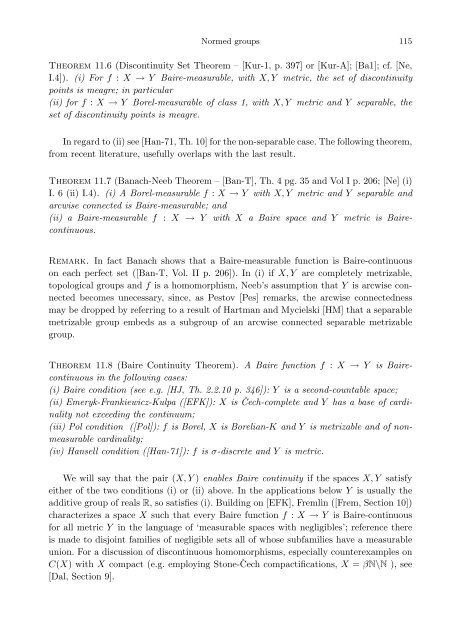Normed versus topological groups: Dichotomy and duality
Normed versus topological groups: Dichotomy and duality
Normed versus topological groups: Dichotomy and duality
You also want an ePaper? Increase the reach of your titles
YUMPU automatically turns print PDFs into web optimized ePapers that Google loves.
<strong>Normed</strong> <strong>groups</strong> 115Theorem 11.6 (Discontinuity Set Theorem – [Kur-1, p. 397] or [Kur-A]; [Ba1]; cf. [Ne,I.4]). (i) For f : X → Y Baire-measurable, with X, Y metric, the set of discontinuitypoints is meagre; in particular(ii) for f : X → Y Borel-measurable of class 1, with X, Y metric <strong>and</strong> Y separable, theset of discontinuity points is meagre.In regard to (ii) see [Han-71, Th. 10] for the non-separable case. The following theorem,from recent literature, usefully overlaps with the last result.Theorem 11.7 (Banach-Neeb Theorem – [Ban-T], Th. 4 pg. 35 <strong>and</strong> Vol I p. 206; [Ne] (i)I. 6 (ii) I.4). (i) A Borel-measurable f : X → Y with X, Y metric <strong>and</strong> Y separable <strong>and</strong>arcwise connected is Baire-measurable; <strong>and</strong>(ii) a Baire-measurable f : X → Y with X a Baire space <strong>and</strong> Y metric is Bairecontinuous.Remark. In fact Banach shows that a Baire-measurable function is Baire-continuouson each perfect set ([Ban-T, Vol. II p. 206]). In (i) if X, Y are completely metrizable,<strong>topological</strong> <strong>groups</strong> <strong>and</strong> f is a homomorphism, Neeb’s assumption that Y is arcwise connectedbecomes unecessary, since, as Pestov [Pes] remarks, the arcwise connectednessmay be dropped by referring to a result of Hartman <strong>and</strong> Mycielski [HM] that a separablemetrizable group embeds as a subgroup of an arcwise connected separable metrizablegroup.Theorem 11.8 (Baire Continuity Theorem). A Baire function f : X → Y is Bairecontinuousin the following cases:(i) Baire condition (see e.g. [HJ, Th. 2.2.10 p. 346]): Y is a second-countable space;(ii) Emeryk-Frankiewicz-Kulpa ([EFK]): X is Čech-complete <strong>and</strong> Y has a base of cardinalitynot exceeding the continuum;(iii) Pol condition ([Pol]): f is Borel, X is Borelian-K <strong>and</strong> Y is metrizable <strong>and</strong> of nonmeasurablecardinality;(iv) Hansell condition ([Han-71]): f is σ-discrete <strong>and</strong> Y is metric.We will say that the pair (X, Y ) enables Baire continuity if the spaces X, Y satisfyeither of the two conditions (i) or (ii) above. In the applications below Y is usually theadditive group of reals R, so satisfies (i). Building on [EFK], Fremlin ([Frem, Section 10])characterizes a space X such that every Baire function f : X → Y is Baire-continuousfor all metric Y in the language of ‘measurable spaces with negligibles’; reference thereis made to disjoint families of negligible sets all of whose subfamilies have a measurableunion. For a discussion of discontinuous homomorphisms, especially counterexamples onC(X) with X compact (e.g. employing Stone-Čech compactifications, X = βN\N ), see[Dal, Section 9].
















